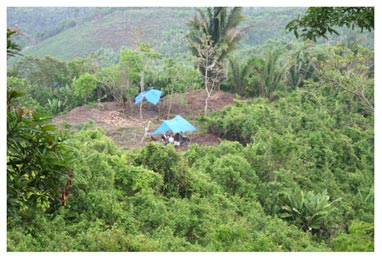| FAMSI © 2007: Keith M. Prufer |
||
The Uxbenká Archaeological Project (UAP) 2006 Field Season
Research Year: 2006 Table of Contents
Abstract The following is a report on FAMSI funded research conducted in 2006 by the Uxbenká Archaeological Project (UAP). Fieldwork was preformed between May 20th and July 3rd 2006 under permits issued by the Institute of Archaeology (IA) and the Institute of Social and Cultural Research (ISCR), National Institute of Culture and History (NICH), Government of Belize. Archaeological studies were directed by Dr. Keith M. Prufer, along with co-PI Dr. Andrew Kindon. Other research programs undertaken by the UAP in 2006 include a pilot for a cave survey program led by Dr. Holley Moyes; sampling of speleothems for development of a rainfall proxy organized by Dr. Kevin Cannariato, Dr. Douglas Kennett, Dr. Keith Prufer, and Brendan Culleton; and applied and anthropological research within the Mopan Maya speaking community of Santa Cruz conducted by Ms. Shoshaunna Parks along with and under the direction of co-PI Dr. Rebecca Zarger and Prufer. Additional project participants in 2006 included Charles Mustain, Bethany Myers, Dr. Mark Aldenderfer, and Nancy Komulainen as well as numerous residents of the village of Santa Cruz. This UAP is investigating Uxbenká, a small but significant site located in the Toledo Uplands of southern Belize. There, hieroglyphic texts from the 4th century suggest a political relationship with the large urban center of Tikal though they do not specify the nature of this relationship. The UAP is utilizing data from intensive archaeological survey and excavations to investigate Uxbenká's settlement history and regional and long-distance economic and political ties over time. Lo que sigue es un informe de una investigación realizada en 2006 con fondos de FAMSI por el Proyecto Arqueológico Uxbenká (PAU). El trabajo de campo se llevó a cabo entre el 20 de mayo y el 3 de julio de 2006, con permisos emitidos por el Instituto de Arqueología (IA) y el Instituto de Investigaciones Sociales y Culturales (IISC) (Institute of Social and Cultural Research), Instituto Nacional de Cultura e Historia (INCH) (National Institute of Culture and History), Gobierno de Belice. Los estudios arqueológicos estuvieron dirigidos por el Dr. Keith M. Prufer, junto con el co-IP Dr. Andrew Kindon. Otros programas de investigación emprendidos por el PAU en 2006 incluyen un piloto para un programa de estudio de cuevas dirigido por la Dra. Holley Moyes; el muestreo de espeleotemas para el desarrollo de una variable indirecta de pluviosidad organizado por el Dr. Kevin Cannariato, el Dr. Douglas Kennett, el Dr. Keith Prufer y Brendan Culleton; y una investigación aplicada y de antropología dentro de una comunidad maya de Santa Cruz hablante de mopán, dirigido por la Sra. Shoshaunna Parks, junto con, y bajo la dirección de la co-IP Dra. Rebecca Zarger y Prufer. Entre otros participantes del proyecto 2006 se contaron Charles Mustain, Bethany Myers, el Dr. Mark Aldenderfer, y Nancy Komulainen, así como numerosos residentes de la aldea de Santa Cruz. Este PAU está investigando Uxbenká, un pequeño pero importante sitio situado en los Altos de Toledo en el sur de Belice. Allí, textos jeroglíficos del siglo 4 sugieren una relación política con el gran centro urbano de Tikal, aunque no especifican el carácter de esta relación. El PAU está utilizando datos de estudios arqueológicos intensivos y excavaciones para investigar la historia del asentamiento de Uxbenká y los lazos económicos y políticos regionales y de larga distancia a lo largo del tiempo. Click to download the report in PDF format: The Uxbenká Archaeological Project (UAP) 2006 Field Season (3.19 MB) The PDF files require Adobe Acrobat Reader.
Submitted 09/15/2007 by: |
||
| Return to top of page | ||
|
Text links to all pages at this site are available at the FAMSI INDEX |
||

